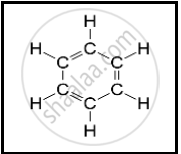Advertisements
Advertisements
प्रश्न
"Carbon prefers to share its valence electrons with other atoms of carbon or with atoms of other elements rather than gaining or losing the valence electrons in order to attain noble gas configuration." Give reasons to justify this statement.
उत्तर
Elements forming ionic compounds achieve this by either gaining or losing electrons from the outermost shell. In the case of carbon, it has four electrons in its outermost shell and needs to gain or lose four electrons to attain a noble gas configuration. If it were to gain or lose electrons -
- It could gain four electrons forming C4- anion. But it would be difficult for the nucleus with six protons to hold on to ten electrons, that is, four extra electrons.
- It could lose four electrons forming C4+ cation. But it would require a large amount of energy to remove four electrons leaving behind a carbon cation with six protons in its nucleus holding on to just two electrons.
Thus, carbon overcomes this problem by sharing its valence electrons with other atoms of carbon or with atoms of other elements and forms covalent compounds.
संबंधित प्रश्न
Why are most carbon compounds poor conductors of electricity?
will CS2 conduct electricity or not?
give reason for your choice.
What type of bonding would you expect between Hydrogen and Chlorine?
Using electron-dot diagrams which show only the outermost shell electrons, show how a molecule of nitrogen, N2, is formed from two nitrogen atoms. What name is given to this type of bonding? (Atomic number of nitrogen is 7)
Draw the electron-dot structure of CO2 compound and state the type of bonding.
State one use of diamond which depends on its 'extraordinary brilliance' and one use of graphite which depends on its being 'black and quite soft'.
Draw all possible structural formulae of compound from their molecular formula given below.
C3H8
Write answer as directed.
What causes the existance of very large number of carbon compound ?
The following structural formula belongs to which carbon compound?

Element A has 2 electrons in its M shell. Element B has atomic number 7.
If B is a diatomic gas, write the equation for the direct combination of A and B to form a compound.
What is the difference between :
Ionic compounds and covalent compounds
Name two carbon compounds used in day-to-day life.
From the following hydrocarbon _______ is the cyclic hydrocarbon.
Write scientific reason.
Carbon has the property of forming many compounds.
Write a short note.
Aromatic hydrocarbons
The number of pi-bonds present in benzoic acid molecule are ______.
Acetic acid was added to a solid X kept in a test tube. A colourless, odourless gas Y was evolved. The gas was passed through lime water, which turned milky. It was concluded that ______.
The table shows the electronic structures of four elements.
| Element | Electronic Structure |
| P | 2, 6 |
| Q | 2, 8, 1 |
| R | 2, 8, 7 |
| S | 2, 8, 8 |
- Identify which element(s) will form covalent bonds with carbon.
- “Carbon reacts with an element in the above table to form several compounds.” Give suitable reason.
______ is an example of a covalent compound having a high melting point.
Statement (A): Covalent compounds are bad conductors of electricity.
Reason (B): Covalent compounds contain charged particles (ions)
